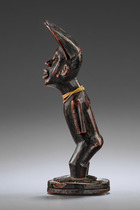Power figure "nkisi nkondi" · D. R. Congo, Yombe · ID: 3046152
Börrisson Family Estate, Sweden
Peter Willborg, Stockholm, Sweden (1991)
Description
wood, wood, small traces of insect caused damage
Peter Willborg once described this finely crafted figure as „perhaps the best figure“ in his collection.
He bought the figure in 1991 from the widow of Niklas Börrisson‘s son, who was already in his late 80s. The proceeds from the sale of the collection were intended to support the local mission church, which was in urgent need of renovation.
Carl Niklas Börrisson (1862-1928) was a missionary from the Swedish „Evangeliska Fosterlands-Stiftelsen“. He worked between 1894 and 1907/08 in the Kinkenge area in Bwende country. During this time he developed into a passionate collector of African artefacts. It is estimated that he collected around half of the Congo material that is currently in the Ethnographic Museum in Stockholm.
After returning to Sweden, he travelled through the country on a bus, where he presented the mysterious African objects to his astonished compatriots and told stories about them.
Börrisson also wrote a catalogue in which he used their local names for all the pieces and mostly also explained their function. The catalogue appeared in 1925 and was remarkably, written not only in Swedish but also in the Bantu language Kikongo.
At first glance, the figure is „naked“, that is, without a magical charge. However, the rudimentary arms suggest that the magic charge was once tied around the body. The figure is also pierced lengthways, from the head and through the body into the disc-shaped base.
An „nkisi“ (also „nkishi“, pl. „minkisi“ / „mankishi“) is an object that is charged with magical substances „bilongo“ and inhabited by a powerful spirit. The figurative form of an „nkisi“, called „nkondi“, represents the most powerful form of these magical objects.
The figures were magically charged by the „banganga“ (master/ priest of the „minkisi“) and used to protect the members of the community against illness, witchcraft and infertility. They could even be successful in hunting or used in a negative sense, for example to inflict evil on another person.
Comparing literature
Tollebeek, Jo (ed.), Mayombe, Tielt 2010, p. 106 ff.
Publications
Tribal Art Magazine, #94, Winter 2019, p. 51AHDRC: 0170775







